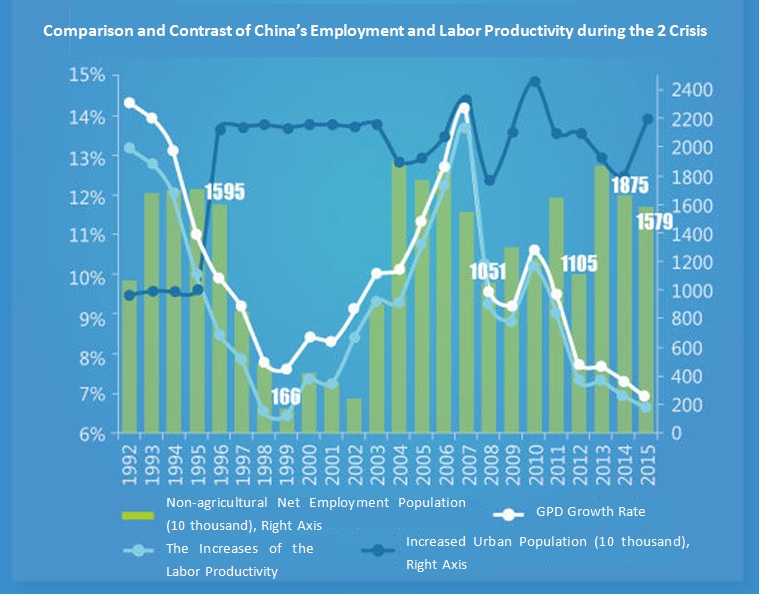The State Statistics Bureau (NBS) released three sets of employment data in its Announcement of the National Economy Situation in 2015:
1. In terms of the age structure, the working-age population ranged from 16 to 59 was 910.96 million, accounted for 66.3% of the total population, 4.87 million fewer than that in the end of the last year.
2. In terms of the urban-rural structure, the permanent resident population of the urban areas was 771.16 million, 22 million more than that in the end of the last year; while the permanent resident population of the rural areas was 603.46 million, decreased 15.2 million on year-on-year basis; the urban population accounted for 56.1% of the total population.
3. The total employment number of the end of 2015 was 774.51 million.
Analyzing the statistics above, we can clearly see three significant changes in terms of the population and employment:
1. The working-age population decreased (from 2012 to 2016, the working-age population ranged from 16 to 59 has cumulatively decreased 15 million), which means the so-called Demographic Dividend Recession.
2. The development of the urbanization has been pushing forward with the increased urbanization rate of 1.33% in 2015; behind which the labor force transferred among the different industries.
3. The employment market mired in situation of the low growth. The national employment population of China gained 1.98 million net increase on a year-on-year basis in the end of 2015, which was the first time when the number was less than 2 million (except 1959 to 1961, during the period of natural disasters in China).
Among those changes, the previous two reflected the changes in terms of the supply of the labor force; the last concerned the changes among the demand of the labor force. Comparing and contrasting the latest two crises (the Asian financial crisis and the global financial crisis) we’ve just experienced, the relationship between the employment and economic growth changed obviously during the crises.

During the Asian financial crisis, the net increase of the non-agricultural employment population rapidly reduced from 15.95 million in 1996 (before the crisis) to 1.66 million in 1999; while the annual increased urban population was in a stale level of 21 million. According to Cai Fang, who is an economist, China’s economy then faced serious problems of unemployment with the unemployment rate of 8%; the economy growth rate and labor productivity growth was rapidly declined at the same time.
The way to solve the crisis at that time was to find a way to fill in the “pit” of the employment market which was caused by the crisis, thus the labor productivity would pick up and therewith the economy would recover. This is exactly the way China adopted to solve the economic problems during the period of 2002 to 2008.
The non-agricultural employment population has basically been in a stable level of 17 million except the periods of the American subprime mortgage crisis in 2008 and the European Debt Crisis in 2012. In 2014 and 2015 the employment population of the agricultural and industrial sector has actually decreased, only among the service sector the number has increased. In other words, the employment market has been in a stable situation since the current crisis, however the growth of the labor productivity all the way declined, so did the economy growth.
Without the “pit” of the employment market, the situation of the economy slow-down seems even more difficult:
1. The decrease of the working-age labor means the weakening of labor price elasticity; in other words, it is more difficult to find the appropriate and cheap labor as before.
2. Although there’s still space for the urbanization rate to increase, the speed may slow down as the rate has already exceeded 56%; meanwhile the labor transfer among the sectors may also slow down.
3. Although the service sector absorbs a number of employment population, our labor productivity hasn’t finish its falling tendency yet. The traditional way of solely focusing on the factor input was not as effective as it was.
The issues are tough and troublesome. The decision-making departments and officials now proposed to implement the reform of the supply front, which means to find an effective way to improve the labor productivity thus to fill in the “pit”. However, from what is going on, the “way” is hard to be discovered merely rely on the analysis of the economists, therefore we should take advices from the scientists and enterprisers to find out what on earth we can improve and what the market exactly lack of.
*This article is a re-edited and translated version by CCM. The original version comes from www.cnchemicals.com/.
If you would like to know more about what's happening in China, go and have a look at CCM's Online Platform! Instant access to CCM's entire resources across 15 segment-industries all at once! Free trial is available NOW, come check it out!
? Access to CCM’s entire resources, literally
? ?Over 180,000 reports, news, data
?? Across over 15 segment industries
GET FREE TRIAL NOW!